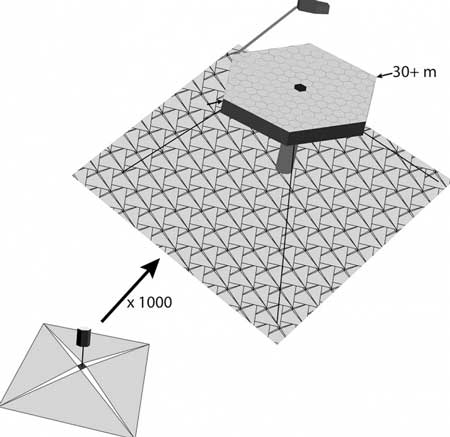| May 01, 2018 |
Self-assembling telescope eyes discovery of new exoplanets
|
|
(Nanowerk News) Sure, it sounds kind of far out: a modular space telescope, nearly 100 feet across, composed of individual units launched as ancillary payloads on space missions over a period of months and years, units that will navigate autonomously to a pre-determined point in space and self-assemble.
|
|
But “far out” is exactly what Dmitry Savransky, assistant professor of mechanical and aerospace engineering at Cornell University, and 15 other scientists from across the U.S. have been asked to give NASA for Phase I of its 2018 NIAC (NASA Innovative Advanced Concepts) program.
|
 |
| A schematic showing one module, lower left, and what the finished telescope might look like, with approximately 1,000 modules assembled together.
|
|
Savransky’s vision for his self-assembling space telescope is all about seeing deep into space to discover new extra-solar planets – planets outside our solar system, also known as exoplanets – and map the surfaces of those we’ve already seen.
|
|
Self-assembly provides a path to the construction of a space telescope the size of which would be infeasible using current design and assembly techniques, such as those for the Hubble and James Webb telescopes. Those telescopes have primary mirrors, the instrument’s “eyes,” of 2.4 meters and 6.5 meters, respectively; Savransky’s would have a mirror in excess of 30 meters.
|
|
Phase I concepts cover a wide range of innovations selected for their potential to revolutionize future space exploration. Phase I awards, announced March 30, are valued at approximately $125,000 over nine months to support each scientist’s initial definition and analysis of concepts.
|
|
If these feasibility studies are successful, award recipients can apply for Phase II awards.
|
|
Savransky is looking forward to the NIAC Orientation Meeting, June 5-6 in Washington, D.C., where he will get to meet with the other Phase I winners and talk about their ideas, which include a shape-shifting moon rover, a wing-flapping Mars explorer and a steam-powered autonomous ocean robot.
|
|
This proposal, Savransky stated in his proposal, is in line with NASA priorities. Self-assembly provides a path, he believes, to the construction of a space telescope the size of which would be infeasible using current design and assembly techniques, such as those for the Hubble and James Webb (launching in 2020) telescopes. Those telescopes have primary mirrors, the instrument’s “eyes,” of 2.4 meters and 6.5 meters, respectively; Savransky’s would have a mirror in excess of 30 meters.
|
|
He readily admits that constructing a large-aperture telescope is “really hard” to do.
|
|
“James Webb is going to be the largest astrophysical observatory we’ve ever put in space, and it’s incredibly difficult,” he said. “So going up in scale, to 10 meters or 12 meters or potentially even 30 meters, it seems almost impossible to conceive how you would build those telescopes the same way we’ve been building them.”
|
|
His idea involves programming thousands of individual hexagon-shaped modules, each 1 meter across and topped with an edge-to-edge active (adjustable) mirror assembly. These would form the primary and secondary mirrors.
|
|
Launched as “payloads of opportunity” – hitching a ride on a NASA rocket – they would navigate to their destination using a deployable solar sail, which would then become a sunshield during telescope assembly.
|
|
Their destination is known as the Sun-Earth L2, or second Lagrange, point – a theoretical point in space where the combined gravitational forces of two large bodies (in this case, the sun and the Earth) equal the centrifugal force felt by a much smaller third body (the telescope). The interaction of the forces creates a point of equilibrium where a spacecraft or observatory can “park.”
|
|
Savransky is looking forward to the NIAC Orientation Meeting, June 5-6 in Washington, D.C., where he will get to meet with the other Phase I winners and talk about their ideas, which include a shape-shifting moon rover, a wing-flapping Mars explorer and a steam-powered autonomous ocean robot.
|
|
Peck, whose research has been supported by NIAC in the past, is excited by Savransky’s vision.
|
|
“If Professor Savransky proves the feasibility of creating a large space telescope from tiny pieces, he’ll change how we explore space,” Peck said. “We’ll be able to afford to see farther, and better than ever – maybe even to the surface of an extrasolar planet.”
|

